Don M. Winn's Blog, page 20
March 3, 2016
Head Bumps and Mental Health: Is There a Connection?
 Have you ever had a bump on the noggin? Has your child? Nearly everyone has bumped their head at one point or another, and this is a subject everyone needs to know a little more about.
Have you ever had a bump on the noggin? Has your child? Nearly everyone has bumped their head at one point or another, and this is a subject everyone needs to know a little more about.
March is Brain Injury Awareness month. Mental health and head trauma may not seem to be related. You may be thinking, ‘What does any of this have to do with me or my children?” The answer is—everything.
Dr. Daniel Amen of amenclinics.com scans human brains, and has documented more head injuries than anyone else in the world. In his experience there is no such thing as an inconsequential head bump. In books, PBS specials, and TED talks he has referred to numerous case histories of folks he has scanned whose lives changed dramatically from what might seem to be “minor childhood head injuries.”
Consider the case history of one set of identical twins. Identical twins have the same genes, the same parents, and the same home background and upbringing. One twin was personally and financially successful: a happily married mom of three who worked in journalism. The other could barely finish high school, struggled with lifelong depression, and had such difficult temper issues that her jobs and relationships were sabotaged at every turn. The difference? The depressed, angry twin had fallen out of the top bunk of their bunk bed when she was 10 years old. The brain injury from that fall and the changes it caused were still visible in adulthood.
I don’t cite this example to discourage bunk bed sales. Nor do I mean to infer that every depressed or angry person should ‘blame’ their condition on the bump on the head they received when they fell off their bike or the monkey bars. Rather, this is to call attention to the fact that we need more awareness and prevention when it comes to protecting our skulls and the precious brains they carry—both our own and those of the loved ones in our care.
Dr. Amen reminds his readers that “the brain is soft, and the skull is hard.” Our skulls have bony projections inside that can severely damage the soft brain when we suffer a blow, bump, fall, or even ‘head-banging’ behaviors we see in many teens enjoying their music. One does not have to suffer concussion to injure their brain and suffer lifelong consequences.
Blows to different areas of the skull can cause different problems. A few years ago I went out to the Amen Clinic in Orange County, California and had my brain scanned. The results were fascinating—we discovered that an injury from childhood had played a huge role in the severity of my dyslexia. And that injury still has a tremendous impact on my day-to-day life.

When our brain works right, we work right. When our brain is troubled, we are troubled. It’s that simple. Several brain areas are especially vulnerable to trauma, especially the parts involved with memory, learning, and mood stability.
With 100 billion neurons (nerve cells), and up to 40,000 synapses, or connections, between each cell, that’s more than the number of stars in the known universe! It’s difficult to imagine such complexity. The combination of our genes and our environment superimposed on all this grand complexity means that we each have thousands of possible ‘trapdoors’ in our brain that may or may not spring open, exposing us to troubling mental health issues. Even an injury affecting a piece of the brain the size of a grain of sand would damage 100,000 brain cells and a billion synapses. Thus the need to focus today on doing as much as is humanly possible to protect our most robust yet most vulnerable body part—our brain.
What are some practical steps we can take to prevent brain injury?
Wear seat belts in the car, and make sure your child is either belted in or properly fastened into an age-appropriate car seat that’s belted in. Always.
Wear a helmet for bike riding or other sports. Always.
Stay off the roof.
Teach your kids not to jump on the bed or other furniture, and make sure there are consequences for breaking the rules.
Only allow an older child to hold an infant under careful supervision. I know one family whose 6-year-old dropped her newborn sibling 5 times (!) over the course of a few months. The sibling now has severe epilepsy as a result of the head traumas.
Don’t roughhouse in areas where there is furniture or an architectural detail with sharp corners.
Follow posted playground safety rules and supervise your kids.
Check out the the Amen Clinic’s page for even more tips for brain health.



February 25, 2016
Revenge of the Quiet Kids
 I don’t know how your school experience was, but looking back and thinking about my fellow students, I seem to particularly remember several kids who always appeared to be leading charmed lives. Popular, erudite, smart, athletic kids from two-parent families, with great teeth, great hair, perfect bodies, and the coolest clothes. Everybody wanted to hang out with them, be like them, and most importantly, be accepted by them.
I don’t know how your school experience was, but looking back and thinking about my fellow students, I seem to particularly remember several kids who always appeared to be leading charmed lives. Popular, erudite, smart, athletic kids from two-parent families, with great teeth, great hair, perfect bodies, and the coolest clothes. Everybody wanted to hang out with them, be like them, and most importantly, be accepted by them.
As a geeky, nerdy, introverted, dyslexic kid with unusually big ears and a very broken home, I often felt left out of the cool club. Way out. Perhaps you had a similar experience.
But a 2014 study from the University of Virginia published in the Journal of Child Development is comforting to those of us who were less cool, or who are the parents of less cool kids.
According to this study, kids who try too hard to be cool often struggle later in life. These kids date earlier, start partying earlier, engage in risky behaviors earlier, and view school as a social event rather than a place to learn. The study followed the lives of 184 Charlottesville, Virginia, kids from middle school through age 23. The participant demographic represents a cross section of socioeconomic and ethnic backgrounds.
Results of the study show that later in life, those cool kids were more likely to have bigger troubles than their less-cool counterparts. As young adults, they were using 40% more drugs and alcohol than the “not so cool” kids and were 22% more likely to be running into troubles with the law.
 “Long term, we call it the high school reunion effect,” said Joseph Allen, professor of psychology at the University of Virginia, who led the study.
“Long term, we call it the high school reunion effect,” said Joseph Allen, professor of psychology at the University of Virginia, who led the study.
“You see the person who was cool…did exciting things that were intimidating and seemed glamorous at the time, and then five or 10 years later, they are working in a menial job and have poor relationships and such, and the other kid who was quiet and had good friends but didn’t really attract much attention and was a little intimidated is doing great.”
“It’s … revenge of the quiet, good kids,” he added.
While most studies of teen behavior focus on success as teens, this is the first of its kind to follow teen behavior as it translates into adulthood.
What behaviors were measured?
How many people had they “made out” with?
Had they sneaked into a movie without paying?
Had they stolen items from parents or family members?
Had they damaged or destroyed property belonging to parents?
Had they used drugs and/or marijuana?
How attractive were their closest friends?
Who they were most likely to hang out with on a Saturday night?
How important it was for them to be popular with as many kids as possible?
Allen says teens trying so hard to be cool early in adolescence find the rewards of popularity in the short term, but their approach ultimately leads to a “dead end.”
“It’s a shortcut to looking grown up, but like lots of shortcuts, it’s keeping them from doing the things that actually make one more mature,” he added. “The detour notion or metaphor really captures it, that they really are off on a different track that was appealing when they took the road but that they just find themselves deeper and deeper in and they have to engage in more and more serious kinds of behaviors to try and get their friends’ approval.”
“So when we talk about alcohol and marijuana use, these are the kids who are most likely drinking three six-packs, when they’re 20 on up, on a weekend night to tell their friend what wild and crazy exploits they engaged in.”
While kids learn important social skills in school, school is not a social event, and treating it as such leads to precious educational opportunities missed.
 “Many of the teens who are going to do the very best in life are the ones sitting quietly on the sideline listening closely to those stories of the wild weekends,” said Allen. “They’re not the ones who are engaged in them.”
“Many of the teens who are going to do the very best in life are the ones sitting quietly on the sideline listening closely to those stories of the wild weekends,” said Allen. “They’re not the ones who are engaged in them.”
What’s the takeaway for parents here?
Encourage your child to develop their love of reading and learning. It will serve them well for life.
Help your child foster sound relationships with peers who share common goals and values, even if that means they have a smaller group of friends
Freely offer your praise of your child’s efforts, character traits, and approval of wise choices. Be verbal and demonstrative. Kids who strive to be cool are looking for peer approval to replace what they’re not getting at home.
Be alert for signs of anxiety or depression in your child that could set the stage for early substance use, and get professional help for your child if you suspect mood issues.
“Pay attention as a parent to what’s going to get your child to a happy spot, to a productive healthy spot as an adult,” said Allen. “Keep your eyes on the long picture and don’t get so distracted by how they’re doing in the short term and what might predict that they’re a little more popular and a little more interesting in the short term.”
Source Material:
http://www.cnn.com/2014/06/12/living/cool-kids-study-parents-duplicate-2/


February 11, 2016
The Secret Lives of Donkeys
A donkey named Grumble has taken me on a wild ride, no pun intended. Work on the third Sir Kaye book, Legend of the Forest Beast, has been a great opportunity to develop non-human characters that play an important role in the story.
Horses, like Sir Kaye’s horse Kadar, have been a mainstay since book one, The Knighting of Sir Kaye. Book two, The Lost Castle Treasure, introduced falconry and a goshawk named Oriana. So what about book three? In book three, Grumble the donkey plays an important, and at times humorous, role in the story.
(See the About Sir Kaye series page.)
Of course, in order to write accurately about a donkey, I needed to do a bit of research. Much to my surprise, I have gained a new-found respect and appreciation for donkeys, so I thought I would share a few fascinating facts about them.
You may have thought, as I did, that donkeys are stubborn, less intelligent than horses, and weaker than horses of the same size. And if you thought that, then you’re in for a big surprise. Donkeys are more like the Clark Kent of the equine family, usually remaining unnoticed compared to the horse, but possessing some amazing abilities.
 Donkeys can live for over 50 years and pound for pound, are stronger, sturdier and more resilient than horses. Donkeys originated in the desert part of the earth, northeast Africa to be exact, and accompanied the Romans when they invaded Britain in 43 C.E.
Donkeys can live for over 50 years and pound for pound, are stronger, sturdier and more resilient than horses. Donkeys originated in the desert part of the earth, northeast Africa to be exact, and accompanied the Romans when they invaded Britain in 43 C.E.
You may have noticed that donkeys have bigger ears than horses. There’s a reason for that. In the desert, where donkeys originated, they are able to hear the call of another donkey 60 miles away. That’s some incredible hearing! Their large ears also serve another purpose: air conditioning. The large surface area of their ears is filled with blood vessels just beneath the skin. When blood flows through their ears, it cools. Then the cooler blood circulates throughout the body—a very important feature to have in a desert environment.
You may be wondering how a donkey’s diet compares to that of a horse. Donkeys don’t just have super strength and super hearing; they also have super digestion. Since food is scarce in the desert, donkeys utilize 95% of what they eat. Their digestive system can break down seemingly inedible vegetation and extract moisture from food far more efficiently than most other animals. If you need fertilizer for your garden, a donkey won’t contribute many nutrients to enrich the soil—he’s used them all up himself.
Donkeys have a reputation for being stubborn. If you were asked to cross a street with cars zipping by, would you? Well, neither would a donkey. Their reputation for being stubborn is actually because of their highly developed sense of self-protection. It is very hard to force or frighten a donkey into doing something it sees as contrary to its own best interest or safety. (If only people were that smart.)

And compared to horses, donkeys show a limited response to fear, pain, and illness. These stoic animals rarely panic and may even appear unresponsive when in distress. When faced with a possible threat, donkeys prefer to plant their feet while they evaluate the situation. Unlike horses, donkeys are not easily frightened. Donkeys are often fielded with horses due to the perceived calming effect they have on nervous horses. If a donkey is introduced to a mare and foal, the foal will often turn to the donkey for support and companionship after it has left its mother. Donkeys are also more independent in their thinking than horses and will reason, then make decisions based on their safety.

Are you impressed yet? Well here are even more incredible facts about donkeys.
Donkeys also have super memories. They can recognize locales and other donkeys they were with up to 25 years in the past, whereas I’m not entirely sure I can remember what I had for breakfast this morning.
Donkeys are also better at reading our body language than we are at reading theirs. That’s important to know when you approach a donkey. You want to be calm, approaching them with the confidence of a leader and with a comforting manner that isn’t demanding. If you are nervous, they will immediately assume there is something to be nervous about. Not good.
Donkeys are often used as guard animals for cattle, sheep and goats since they have a natural aversion to canines and will keep them away from a flock.
Like Superman, donkeys also have their Kryptonite. Donkeys don’t like the rain and being out in it for long periods can damage their health because their fur is not waterproof.
There’s also a tender side to donkeys.
Donkeys are social animals, enjoy company and develop strong emotional bonds with other animals. Donkeys often pick a best friend, with whom they spend most of their time, and pairs of them are frequently observed grooming one another. When separated from their companions, donkeys become noticeably anxious and distressed, often vocalizing, pacing, and even falling into depression.

Training a donkey relies upon showing him or her, by words and action, that they can trust you to protect them from harm. They learn what it is we want them to do if we take time to show them.
And finally, if you want to get on a donkey’s good side, scratching them under their chin is a very effective way to make friends. But be aware that the area around the eyes and ears of a donkey is a very personal space—so avoid touching them there on first greeting.
These fun facts have caused me to rethink my preconceptions about donkeys—it’s been a good reminder to avoid jumping to conclusions about things when I don’t have all the facts!
So what exciting role will Grumble the donkey play in Legend of the Forest Beast? Well that bit of news will have to remain a secret for now. But don’t worry; Legend of the Forest Beast will be making its debut very soon, so stay tuned.


January 28, 2016
Bookshare: Making Books Accessible to Everyone
 If you or a loved one is struggling to read due to print disabilities of any sort, you will be thrilled with today’s interview. Help—great help, in fact, is available! And most is free or low cost! I am so excited to introduce dyslexic reading specialist Matthew Hattoon, M.Ed., of Bookshare.org. He is a great resource for cutting-edge information on teaching techniques, along with technology and tools for reading.
If you or a loved one is struggling to read due to print disabilities of any sort, you will be thrilled with today’s interview. Help—great help, in fact, is available! And most is free or low cost! I am so excited to introduce dyslexic reading specialist Matthew Hattoon, M.Ed., of Bookshare.org. He is a great resource for cutting-edge information on teaching techniques, along with technology and tools for reading.
Don: How did you become interested in working with dyslexia and other print disabilities?
Matt: I was a reading teacher in a public school and observed that some of my students had unexpected reading difficulties, when contrasted with their performance with academic duties that did not involve decoding written material. After researching this phenomena, I realized that many of these students exhibited characteristics of dyslexia. I then had the good fortune to be given the opportunity to train with Margaret Taylor Smith, the creator of the MTA dyslexia remediation program, and developed a lifelong passion for working with dyslexic students.
Don: Are there any facets of dyslexia or other print disabilities that you find are very poorly understood?
Matt: All too often, dyslexia is unidentified and/or misdiagnosed. Students who could benefit from dyslexia remediation are not getting services they need in a timely fashion and have a difficult time in school due to their problems with reading traditional print. Dyslexia is also widely misunderstood. It is often viewed as a deficiency in intelligence or determination or simply a problem with seeing letters in the wrong order. We have come a long way in our understanding of dyslexia, but many of these misconceptions still hinder students.
Don: Please describe the multi-sensory approach to teaching reading.
Matt: Most multi-sensory dyslexia remediation programs are based upon Orton-Gillingham techniques, in which teaching is done using all learning pathways in the brain (visual-auditory, kinesthetic-tactile) simultaneously in order to enhance memory and learning.
Don: How is technology assistive to those of us with reading challenges?
Matt: There are a wide range of assistive technology (AT) tools available to help individuals who struggle with reading. While each type of tool works a little differently, most of these tools help by presenting text as speech. Some, such as Bookshare Web Reader, also include synchronized, highlighted text and allow the reader to change font size and style and page contrast to suit their personal preferences. These tools help facilitate decoding, reading fluency, and comprehension.

Bookshare Web Reader lets you change the font size, style, and page contrast according to your personal preference, with the possibility of using a dyslexic-friendly font.

Bookshare Web Reader provides synchronized, highlighted text in combination with its text-to-speech function.
Don: Are there any new developments in technology in the works for those with print disabilities?
Matt: Image description in accessible text has long been problematic. The DIAGRAM Center, a Benetech Global Literacy initiative, has been doing some amazing work in that regard. It is a research and development center whose goal is to dramatically change the way image and graphic content for Accessible Electronic Media (AEM) is produced and accessed, so that students with print disabilities are provided equal access to the general education curriculum.
Don: What does Bookshare.org offer to members? To educators?
Matt: Bookshare is free for qualified US students and the educators who serve them, and it opens up the world of reading for people with print disabilities. If a person cannot read traditional print books because of a visual impairment, physical disability or severe learning disability, Bookshare can help! It is the world’s largest online library of copyrighted ebooks for people with print disabilities. Books are available in a variety of formats that allow reading on a range of computers and devices.
As a result, people of all ages, as well as schools and many organizations around the globe can access the books they need for school, work, career advancement, skill development and the simple love of reading, in formats that work for them.

Don: What do you feel is the most important thing for parents of dyslexic children to understand?
Matt: Early identification and remediation is key. With proper training, your child can become a successful reader.
Don: Do you have a favorite success story to share with our readers?
Matt: There are so many! Any person once categorized as a “slow learner” who has become academically successful and developed a love of reading once they were given the training and tools needed to interact with print is a success story!
Don: Anything else you’d like to include?
Matt: Don’t give up! There is help available through organizations such as the International Dyslexia Association and Decoding Dyslexia . For more information regarding Bookshare, visit our website (www.bookshare.org).
If you have comments or questions, we’d love to hear from you. We also love to hear your success stories! Thanks in advance for reading and sharing.
P.S. Here’s a link to Pinterest pics of kinesthetic learning desks
and an interview with teacher Stacey Shoecraft, who has a kinesthetic classroom.


January 14, 2016
Helping Children with Dyslexia: Showing Patience and Understanding
Patience. So important, and yet so difficult to practice. Demonstrating patience in situations where we have limited understanding can be nearly impossible.
As parents and teachers, we are often called upon to show patience and understanding towards the children under our care. This is especially true when they are struggling with something that we’re not familiar with or don’t understand well. Children with dyslexia often fall into this category.
Even parents and teachers who have a basic comprehension of dyslexia and some of the challenges that go with it, can at times miss the boat in showing understanding and patience. This is especially true when certain behaviors fall outside of our expected construct. There can even be a lack of understanding between one dyslexic and another.
One reason for this is that not all of us dyslexics are alike. Although we share certain traits in common, there is a wide range of complications that can vary significantly from one dyslexic to another. The severity of the dyslexic symptoms can vary widely too. We don’t all fit in the same mold. One dyslexic may struggle in a particular area that might not be as much of a problem for another dyslexic and vice versa.
And therein lies the challenge.
We may not always have understanding, or a working grasp of the finer points and implications of the situation, but we can strive to show patience and kindness. We thereby create the environment and the space to work towards gaining better understanding.
Unfortunately we often fall short of this ideal, maybe reacting with frustration, disappointment, or even anger when our kids fail to perform up to our expectations.

There was one event from my childhood that illustrates the toxicity of the latter reaction very well, and it left an indelible impression on me.
Grade school in general was a very stressful time for me—not just because of my difficulty with reading. My challenges encompassed the entire gamut of dyslexia-related difficulties—i.e. sequencing, spatial/temporal (directions), motor control (handwriting), listening (note taking), organizational, and so on. My first grade teacher, Mrs. Carson, was always very kind and patient with me, but the same can’t be said for all of my other teachers. My grade school gym teacher comes to mind.
I believe we were preparing for some kind of class performance, which is all I can remember about it, where he (the gym teacher) had all of us kids stand in a circle, hold the edge of a parachute and do a synchronized dance. He would have us go in various directions, including having the parachute go up and down in the air, all to the 1967 song “Up, Up, and Away” by the 5th Dimension.
Because of my ineptitude with directions I could not respond quickly when he would say, “Go to the right or to the left.” I would have to think about it to get my bearings.
I was obviously a fly in his ointment—he looked at me as though I was willfully not paying attention and goofing off. He became angry with me, verbally at first. But then when I still was not responding quickly to his angry directions he would kick me repeatedly on the backside to get my attention, kicking to the right or left as the direction of the dance changed.
Although I didn’t show it at the time, I was extremely humiliated. I seethed with anger. Though it may not have seemed so, I was doing my very best, and being humiliated for it. Even after decades have passed, this memory is still very vivid. I can’t recall it without feeling the same anger I felt as a child. This may sound terrible to say but if my adult self were there with my younger self, I may have given that gym teacher a kick in his own backside. Even the song “Up, Up, and Away” is repellent to me because it is forever connected with that memory.
That gym teacher not only understood nothing about dyslexia, but he also failed to recognize that it’s entirely possible for a child to be doing his or her very best and still not perform to expectation. He made an instant judgement that my lack of skill resulted from an attitude problem—i.e., my character.
There’s a big difference between character and genetics, chemistry, and learning challenges. Any and all of these things can (and do) influence behavior, but it’s our response to these different influences that will help or hinder a child from making progress. We can learn to recognize which factors are at play and respond effectively and patiently.

When our child or student is not performing as desired, staying on task, or “getting the point,” do we keep teaching and interacting the same way, perhaps more loudly or with evident frustration, while expecting a different outcome? To do so is pointless and harmful. A better choice?
Take a breath. Calm down. Your child is likely not being willfully obstreperous, but rather is not able to process the information in the way it was conveyed.
Take a break. If you are frustrated, likely the child is as well. Have a snack, take a few minutes to dance to some fun music or even do some jumping jacks.
Spend a few minutes talking about something pleasant, ideally something you recall your child doing that you were particularly proud of, or something fun you did together.
Don’t rush. For many kids with learning challenges, including dyslexia, extra time is needed to process information and perform required tasks.
Give complex instructions a step or two at a time.
Keep your perspective. Remember that you and your child are making a memory together. What do you want them to remember most?
Balance is key. Parenting and teaching involves striking a balance between accepting children for who they are and helping them become their best selves.
For in-depth consideration of this topic, please refer to Far From the Tree by Andrew Solomon, the most erudite dyslexic I’ve ever had the pleasure of reading.


January 6, 2016
Make a Positive Difference in a Child’s Life by Mentoring
Wow. I’d like to let you know that I received a robust volley of emotion-filled replies to my recent blog about the misperceptions surrounding dyslexia. A big shout out to all my wonderful readers! So many folks shared their childhood experiences, and many of them had not even been diagnosed until adulthood. As I read people’s stories, it got me thinking about how we can find meaning in those early struggles. Pain and suffering are not fun, but can they be turned into something positive?
When you have dyslexia, you become intimately acquainted with failure at a tender age. Our brains don’t work like non-dyslexic brains, and that causes many complex challenges. After failing repeatedly, perhaps being held back a grade a time or two, we can develop a pervasive fear of failure. We can feel broken and hopeless. And of course since dyslexia is life-long, these struggles don’t go away. They are forever a part of our daily life. Might sound kinda grim, and it might often feel that way too.
But how can we use these personal experiences to help others? In a word, mentoring.

When we seek out kids who comprise the next generation of dyslexics, we have so much to share. Think about it: what would it have meant to you to have someone in your life, just as you became aware you were different, telling you they understood how you felt and offering helpful suggestions? What if they told you that you might feel broken and ashamed, but that you were not broken, your brain just worked differently? Maybe they could have even explained how toxic shame is to the human heart and spirit, and helped you develop a healthy inner dialog to foster self-esteem. What if they showed patience and kindness, and helped you in fun, practical ways with your reading and writing? I daresay that such a mentor could change a life in a profound and powerful way.
Here’s the thing: as an adult with dyslexia, you have just such an ability. Here are some ideas to get you started.
If your child, student, grandchild, or family friend is very young—say, elementary school age or younger—start with a fun, instructive story about mentoring and asking for help. Failure, or fear of failure, is one of the greatest challenges in pursuit of our passions. I’ve written a picture book called Chipper the Clown that could help with this. It tells the story of a man who pursues his dream, encounters stumbling blocks along the way, and eventually succeeds with the assistance of mentors. This story encourages children to pursue their passions in life. It teaches them not to give up when they don’t succeed the first time, but rather, to be willing to ask for help.

Some other practical ideas:
Beware of information overload when mentoring. Children may find it difficult to remember many things at once.
Speak slowly, pause between phrases, and maintain good eye contact.
Give verbal instructions in a quiet place if possible.
Give concise instructions in the exact order they need to be carried out. Since sequencing is often a problem, be prepared to offer instruction a step or two at a time.
Engage kinesthetic learners by counting off steps on your fingers. As the child watches you count items off on your fingers, he/she will “anchor” each item to it’s appropriate finger.
Ask the student to repeat back information/instructions while “anchoring” on his/her own fingers—this will ensure that there has been no misunderstanding.
Repeat or rephrase things as necessary.
Visually indicate left or right if this is part of the task.
Be willing to share freely form your own experiences: feelings, thoughts, self-esteem challenges you’ve faced, and how you’ve learned to cope with the ongoing challenge of your dyslexia.
Be quick to commend for hard effort, creativity, verbal abilities, interpersonal skills, spatial skills, and problem solving.
Along with commendation, help the child discern their strengths and feel good about what they bring to the table.
Be patient.
January is National Mentoring Month. Help a special child recognize that mentors are all around us, and that they can make a real difference in our lives.
Here’s a great picture book for National Mentoring Month. In Chipper the Clown, Chipper learns that in order to follow his dreams, he needs help. This story is about the benefits of asking the right people for help and the value of mentoring.

Helpful links:
Chipper the Clown Book Trailer
Chipper the Clown on Amazon.com
Chipper the Clown on Amazon.ca
Chipper the Clown on Amazon.co.uk


December 31, 2015
Look Back, but Keep Moving Forward
Many of us have a special memory of a time in our lives that we remember with fondness. Sometimes we even wish we could go back and relive those moments of our lives again. I was reminded quite poignantly a few years ago that no matter how good a memory may be, it’s only a memory, and other than in our dreams, we can’t go back and relive it.
When I was about 13 or so, after I was abandoned by my mother, my dad and I lived for a year with my Great Aunt Rose. Because of my dad’s work schedule, most of the time it was just Aunt Rose and me. Aunt Rose had a small farmhouse with about 5 acres in a rural area outside Tulsa, Oklahoma. While I lived with her, she raised chickens and ducks, had a few horses, and cared for a huge garden. I remember many an evening when we would sit outside on the back porch looking at the stars while snapping green beans from the garden. We had a lot of great conversations during that year. And although she owned a television, it was very rarely ever on—although she liked watching the Waltons occasionally. Aunt Rose had been very close to my grandmother, her sister, who passed away when I was about 10, and she basically took over being my grandmother after that. Coming from a broken home, the memory of my time with Aunt Rose is very special to me and sometimes I wish I could go back and relive those memories.

Aunt Rose third from the right, my brother Marty in front of Aunt Rose, and my grandmother Minnie, far left. I was still a baby during this time and wasn’t in any of the photos.
By the time I was 18, Aunt Rose was too old to care for the farm any longer, so she sold it to her grandson, Donny. Donny remodeled the home and built a machine shop on the property that he operated for many years.
Right after my father died (I was about 21) I stayed briefly with my cousin Donny in the remodeled home and sadly that was the last time I ever saw Donny or my great Aunt’s farmhouse again.

Aunt Rose top center and Donny far right
About 2 years ago my wife and I took my mother’s ashes to my father’s gravesite in Sinnett, Oklahoma and while there, we visited the site of my childhood memories of Aunt Rose—her old farm house. To my surprise, shock actually, the house and the machine shop, everything that was on the property, was completely, mysteriously gone—the only thing there was bare acreage. Not even a mailbox remained. It was as if a massive tornado dropped down and carried everything away. Perhaps it did. We haven’t been able to find a trace of any of the family or what happened to the old family farm. This was a sobering reminder that our memories of past events are all that we have of those events and we can never go back.

My Aunt Rose, top center and my Grandmother Minnie, bottom right.
Of course, there are some memories where the inability to ‘go back’ is a good thing, especially our bad memories. But here’s the thing: when negative memories are made during our formative years, those first impressions made early in life lay the foundation for our belief system later in life. And when the impressions of difficult childhood events are not challenged or redirected early on, they can wreak havoc on us throughout our lifetime. As the saying goes, “We always revert to our earliest hurt.”
Although these negative memories can involve any aspect of our lives, for this blog I’m specifically thinking about how I struggled terribly with dyslexia in school and the negative self-belief system about myself that I formed at a very young age—i.e. I’m stupid, broken, don’t fit in, etc. A negative self-belief system like this can stifle growth and even make later successes in life feel like they’re undeserved. Negative beliefs zap us of our happiness. But there’s good news! We can change our belief system, even one that’s been with us for most of our life.
I remember something I heard a long time ago that’s very apropos to this situation and that is that the wake of the boat (the things behind) is not what drives the boat. It’s just what’s left behind. When we operate from the events of our past (our negative self-belief system), then we’re allowing our wake to drive us. And limit us! The sad truth is that the wake of a negative self-belief system developed in childhood will not lead us anywhere good. We will always remain in the bad place we lived as a child until we challenge those negative beliefs about ourselves and change them.
So if like me you’ve struggled over the years with a negative self-belief system, what can you do now to reprogram your negative thoughts and begin moving forward instead of just looking back?
Here are some facts that have helped me see my negative self-beliefs from a new perspective:
Most negative beliefs about ourselves come from childhood, based on ideas we received from parents, teachers, or other authority figures. When a two-year-old says, “What’s that?” and an adult says, “That’s a dog,” we believe them. But what about when an adult says, “You’re just being lazy,” or “You’re stupid,” or “Why can’t you be more like your brother?” we also believe them. We grow up feeling inferior, believing that all the negative talk was gospel truth.
Negative beliefs about ourselves force us to filter the information in our lives to conform to the subconscious beliefs we have about self and the world. We can actually end up looking for evidence to prove how bad we are! How many times have we declared after some failure or disappointment, “I can’t do anything right,” or “I’ll never be good enough to ______.”
Negative beliefs about ourselves force us to live below our potential. After being told dozens (maybe hundreds) of times, “You’ll never be a good reader,” or “You’ll never have good comprehension,” or writing skills, or whatever…we stop trying. We stop showing up for our own life since it seems like an exercise in futility, according to those authority figures in our youth who prophesied that we’d never amount to anything.
What to do about all this?
Question the limiting belief. Get curious about it: is it really true that I’m lazy or stupid? What does the evidence show? Is it based on solid fact, or is it based on feelings and early programming, or lack of understanding?
Remind yourself that negative self-belief is a habit. Each time we notice old ‘tapes’ playing in our head, we must constantly challenge them. Keep questioning yourself by asking things like: Is this really true? Or am I just tuning in to the clues my subconscious mind wants to recognize to reinforce my old beliefs about myself?
Do something differently. If we normally react to a stressor, memory, or challenge a certain way, and we don’t like the usual outcome, we can choose to respond differently. This tip is especially important to those of us with learning issues like dyslexia. We simply cannot learn efficiently the way most people teach. We have to discover our own learning style, processing style, writing style, and reading style. This takes great tenacity.
Tenacity is built on a foundation of self-worth. We build self-worth through seeing our weaknesses and struggles with compassion, not self-loathing. We may have had a vivid and active inner dialog of self-loathing our whole life, but with time and patience, we can change how we relate to ourselves. When we feel a self-limiting belief crop up, instead of getting instantly frustrated, we can learn to soothe ourselves through compassionate self-talk. Try something like this: “There goes my mind down that rabbit hole again. I understand why this happens sometimes. I was repeatedly told negative messages about myself by people who didn’t understand me or who got frustrated because they didn’t know how to help me. But I am learning to help myself. I am actually working very hard, and deserve to feel good about my whole-hearted efforts. I may have hit a roadblock here, but by persisting I can get this figured out and do well with this challenge.”
Remember, dear readers, your past does not equal your future. Good or bad, we can’t go back. But we can, and shall, keep moving forward!

Me and my dad when I was really little.


December 17, 2015
Gemstones in the Middle Ages Part 2
Who knew gems and handwriting overlapped in medieval times? I didn’t—at least not until doing some research about gems and gem cutting for Kaye 3. How are gems and handwriting connected?
First of all, it’s important to remember that handwriting (and spelling) was far from standardized back then. The distinctive personal signature (like John Hancock’s on the Declaration of Independence) was almost unheard of during the middle ages. But people still needed to write to communicate, to transact business, create contracts, leave property to their family in a will, etc. So one way to protect important documents was to have a skilled craftsman design a distinctive carved stone, usually set in a ring, called an intaglio. The carved out design could then be pressed gently into a puddle of melted wax to seal a folded document, protecting it from prying eyes and proving to its recipient that it was authentic.
 Stones like amethyst, agate, garnet, onyx, ruby, or beryl were often used for these rings. A skilled carver could take hundreds of hours to carve a detailed design. How? Well, if you’ve ever seen your Mom or Grandma file her nails, using something called an “Emery Board,” you’re on the right track. Emery is an actual mineral, a rock from the earth, that has been mined for over 2000 years on the Greek Island of Naxos. It has been used as an abrasive to polish things by people all over the world, and was used in medieval times to slowly remove areas of the stone’s surface to create the desired design.
Stones like amethyst, agate, garnet, onyx, ruby, or beryl were often used for these rings. A skilled carver could take hundreds of hours to carve a detailed design. How? Well, if you’ve ever seen your Mom or Grandma file her nails, using something called an “Emery Board,” you’re on the right track. Emery is an actual mineral, a rock from the earth, that has been mined for over 2000 years on the Greek Island of Naxos. It has been used as an abrasive to polish things by people all over the world, and was used in medieval times to slowly remove areas of the stone’s surface to create the desired design.
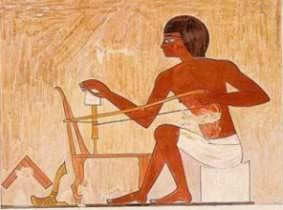
Egyptian bow drill
Of course, there were no power tools back then, so the stonecutter couldn’t use a drill in the sense that we think of them today. But they did have hand operated tools somewhat like a bow drill or a lathe that could be used to speed up some of the less detailed work in carving the gem. However, the most sought-after intaglio artists took few shortcuts and did intricate work that defied forgery.
During the Middle Ages, carved gems were prized not only for their fine designs, but for the beauty of the stone itself. Numerous ancient writers described precious and semi-precious stones and their (believed) natural, supernatural, and even magical qualities. Folks back then believed that wearing such stones protected them from danger. Wealthy people wore them as personal ornaments because they were beautiful
The first known gem collector documented by historians was Mithridates the Great, the Greek king of Pontus (now located in the eastern Black Sea region of Turkey). Since he lived from 134-63 BCE, or over 1100 years before Medieval times began, we can begin to get the sense of how long people have been fascinated by carved gems. When Mithridates was defeated by the Romans, his gem cabinet full of treasures was taken to Rome and offered up as a gift at Capitoline Temple. His impressive collection made the Romans fall in love with the luxury art of gem cutting and carving, and any who were wealthy enough to afford them became collectors. You can see some examples below or at the Metropolitan Museum of Art website.
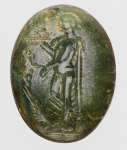

 The Romans became masters of gem carving techniques. They even developed iron tools tipped with crushed diamonds to help them carve gems. These tools were so valuable and famous that they were exported to China and India and were given as gifts to kings.
The Romans became masters of gem carving techniques. They even developed iron tools tipped with crushed diamonds to help them carve gems. These tools were so valuable and famous that they were exported to China and India and were given as gifts to kings.
After the fall of the Roman Empire, much of the technical knowledge and skills required to create highly detailed carved gems vanished. During the Middle Ages, intricately detailed gem carving was something of a lost art, except in certain areas.
To make up for their lack of skill at gem carving, wealthy people and churches during the Middle Ages collected examples of ancient carved gems from Greek and Roman times and incorporated them into their own medieval art.
An excellent example of this is in this closeup of the Cross of Lothair to the right. The large carved gem at the top is actually a Roman intaglio of Augustus. Two stones below that is a small carved amethyst (purple) depicting three women. If it looks funny to you, that’s because it’s set sideways.
How does this information play into the third Sir Kaye book, Legend of the Forest Beast? Stay tuned!


December 10, 2015
Gemstones in the Middle Ages Part 1
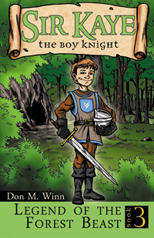 When I was a kid, I loved collecting things I found. I think that’s why Reggie, a character in my Sir Kaye the Boy Knight children’s book series, does the same thing. I especially loved collecting rocks and minerals. It wasn’t something I could find laying on the ground, but as a kid, one of my favorite minerals was pyrite. Whenever I did get hold of some pyrite, it was easy to convince my friends it was real gold and I could trade it for other valuable items—hey, I never said I didn’t have moments as a little stinker.
When I was a kid, I loved collecting things I found. I think that’s why Reggie, a character in my Sir Kaye the Boy Knight children’s book series, does the same thing. I especially loved collecting rocks and minerals. It wasn’t something I could find laying on the ground, but as a kid, one of my favorite minerals was pyrite. Whenever I did get hold of some pyrite, it was easy to convince my friends it was real gold and I could trade it for other valuable items—hey, I never said I didn’t have moments as a little stinker.
Anyway, during my rock-collecting years as a kid, there would have been nothing cooler than for me to be collecting rocks off the ground and to suddenly stumble upon a beautifully cut and polished gem just lying in the dirt. A colorful gem like that would have been the prize of my collection and I would never have traded it for anything. So recently I thought to myself, “What if something like that were to happen to Reggie…”
Don’t worry, I’m not giving away any spoilers today. However, while working on Legend of the Forest Beast, I’ve had to do a little research about medieval gems and jewelry and I do have a few interesting facts to share.

This is not an actual medieval treasure, but it’s a cool picture.
Most gemstones start out looking like ordinary rocks. They have to be cut and shaped and polished before they are ready to be worn as jewelry. When you think of gems and jewelry today, you might think of a ring with a sparkly stone in it.
If you look closely at one of those sparkly stones, you will notice that it has many, many flat sides and it most likely has a pointed back. The flat sides are called facets, and this way of cutting a gem is called a faceted cut. Medieval gems did not look like this. The knowledge and technology to make facets didn’t exist until near the end of the middle ages. Instead, cut and polished gems during the middle ages were smooth and rounded with a flat back, almost like half a round bead or half a marble. This style of shaping and polishing a gem is called a cabochon cut. Cabochon cut jewels in the middle ages were not always perfectly rounded. Sometimes they were kind of lumpy-looking.
Here’s a diagram illustrating the difference between cabochon cut gems and faceted gems:
 Here are some photos of medieval rings. Notice the domed shape of the cabochon cut stones in the rings.
Here are some photos of medieval rings. Notice the domed shape of the cabochon cut stones in the rings.

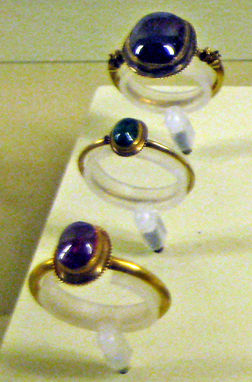
Medieval England (which is the basis for my fictional land of Knox) had to import most of its precious stones from more exotic climes. Amber, pearls, jet, and corals were all that were locally available. The most valuable and most desired imported gem was the ruby, followed by sapphires, diamonds, emeralds, and another kind of pale red stone that was called a balas ruby.
In Part 2, next week, I’ll share some interesting facts I’ve learned about how gems in the middle ages were used and their curious connection with handwriting.


December 2, 2015
Don M. Winn Student Interview Part 2
Here’s the continuation of Austin Community College student Christi Esquivel’s interview of me.
Christi: Where do you find inspiration to keep writing?
Don: Inspiration is everywhere, even in movies.
One movie that I really like is Julie and Julia. I would recommend watching that. In the movie, Julie lives in a big city, working at one of those phone-support type jobs. Just the normal, frustrating, daily grind, but she loved cooking and she loved Julia Child. She had a big recipe book and she had the idea that she would make a recipe regularly, and then post about her experiences. She started her own blog and shared all her frustrations, all her successes, all her experiences with cooking. People started following her. She ended up with such a huge following that her blog ended up becoming a book and a movie. The movie was enjoyable because it went from her life, flashing back to Julia Child and how she started. Meryl Streep played Julia Child and gave her usual stunning performance. The movie is very inspiring because it reminds us that you can start off small, do what you love, and end up being successful.
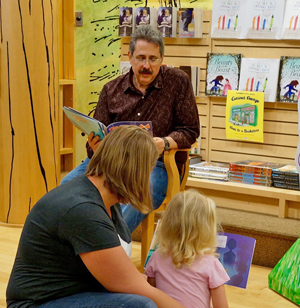 Another movie I like is based on Beatrix Potter. It’s called Miss Potter. It showed how she just had to write and illustrate her stories. No one took her seriously. Even the publisher she went to said her work was just okay, almost to humor her. But the publishing house was a family business and the younger brother wanted to be a part of it. The older brothers ended up giving him Beatrix Potter’s project to work on because the younger brother had been nagging at them to let him be a part of the family business. Well, what was funny about it was that when he saw her work he thought it was great. He worked with her to get it published, and, of course, we saw what happened. The books are classics and still enjoyed today. It was another very inspiring story. Stories like that show that sometimes we may have a lot of negative responses from people, but don’t pay any attention to that. If you enjoy it, just do it. Get it out there, keep working on it, and eventually something good will happen.
Another movie I like is based on Beatrix Potter. It’s called Miss Potter. It showed how she just had to write and illustrate her stories. No one took her seriously. Even the publisher she went to said her work was just okay, almost to humor her. But the publishing house was a family business and the younger brother wanted to be a part of it. The older brothers ended up giving him Beatrix Potter’s project to work on because the younger brother had been nagging at them to let him be a part of the family business. Well, what was funny about it was that when he saw her work he thought it was great. He worked with her to get it published, and, of course, we saw what happened. The books are classics and still enjoyed today. It was another very inspiring story. Stories like that show that sometimes we may have a lot of negative responses from people, but don’t pay any attention to that. If you enjoy it, just do it. Get it out there, keep working on it, and eventually something good will happen.
Christi: What kind of secondary skills are most useful?
Don: You’ve probably always heard the expression write what you know. Well, if you don’t know a lot, it’s kind of hard. You may know a little about a lot of things, but it’s really hard to write something meaningful if you don’t know the subject you’re writing about very well. I think it’s great if there’s a certain genre you want to write, or even blog about. It’s great to spend as much time learning everything you can about it. If you want to write about travel, it’s kind of hard if all you do is watch the Travel Channel on TV. To be a good travel writer, you actually have to be out there traveling. If you want to write about photography you need to be out there doing it and learning everything you can about it.
I think that in itself will give you what you need to really do a good job producing something meaningful for people, something that goes beyond just regurgitating something someone else wrote. Writing is kind of secondary; you have to have something to write about. The first thing to do is to figure out what sort of things you are passionate about. Then work on excelling in those things. Then learn how to express what you want to about it through writing.
Christi: What kinds of contacts would you say are necessary for success?
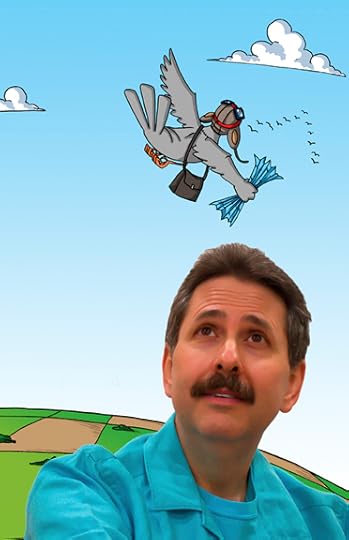
Don in a scene from The Higgledy-Piggledy Pigeon
Don: It’s good to network with others that enjoy writing as well. However there’s a funny thing that happens with a lot of people who want to be writers, they end up feeling like they’re in competition. They should never feel that way, because writers can help each other. Some of the really good writers are very good about networking and helping and encouraging other writers. It’s possible that some authors might feel that if they help another author then they’re just adding to their competition, but usually it’s the opposite that’s true. A person doesn’t want to just read one book from one author.
Network with others that have the same passion and that are willing to share that with you, help you, and encourage you and vice versa. It’s kind of a mutual thing. I think that’s great. As far as the things you want to write about, it’s good to network with people who have an interest in that. That way, you gain a rapport with your core audience and you’re also learning a lot more about your passion. You’re learning what other people enjoy about it and you’re sharing that with them. That’s what I would suggest.
Many thanks to Christi for allowing me to share her interview with my readers!





